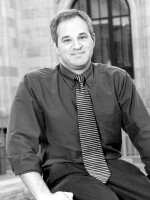Even the most frequent fliers have probably never taken a plane trip to Vernal, Utah, or Rockland, Maine. Those towns have two of the nation's smallest commercial airports.
But whether or not you were a passenger on them, you've helped pay for flights to those cities and more than a hundred others, under a federal subsidy program that helps small airports maintain commercial service. This year, Congress is spending $175 million on the program, which critics call wasteful but which some communities consider an economic lifeline.
Last month, at the airport in Hot Springs, Ark., scores of residents and dignitaries crowded into the tiny 1940s-era terminal to help Mayor Mike Bush celebrate something other airports take for granted. For the first time in more than a year, Hot Springs — a city with fewer than 40,000 residents — is being served by a commercial airline.
"I want to welcome everybody to this glorious occasion," Bush said at the event. "We've got airline service, y'all. Let's give 'em a hand."
Commercial Airlines Take Advantage Of Subsidy
If you're used to flying into bigger cities, the new Hot Springs service may be a bit underwhelming. It's provided by a small carrier called Seaport that offers three daily round trips to Memphis on a single-engine, nine-passenger propeller plane. But airport director George Downey says even that level of service is a big deal for Hot Springs community leaders.
"It's very important for economic development, because it is something positive that they can answer to any company wanting to relocate," Downey said. "Usually, that's the first or second question on any questionnaire: Do you have local air service?"
Twice in the past decade, other airlines have started commercial flights to Hot Springs, only to discontinue them for a lack of passengers. So why is Seaport trying again? Partly because it's getting a federal subsidy to do it.
Hot Springs is among about a hundred small cities included in what's known as the Essential Air Service program. That means airlines can collect hundreds or even thousands of dollars in federal subsidies for each passenger they fly. Seaport CEO Kent Craford says the government is giving the airline more than $1 million a year to serve Hot Springs.
Program Dates To 1970s
"One thing about the Essential Air Service program is that the risk is mitigated by the subsidization of the air service, so we just see a lot of upside in it," Craford said. "Without the subsidy, we wouldn't have taken the gamble to initiate service."
The EAS program isn't new. It dates to the 1970s, when Congress deregulated the airlines and wanted to protect rural airports. But over the years, the subsidies have steadily grown and attracted their share of criticism. Many of the cities the program serves — including Hot Springs — are within an hour's drive or so from bigger airports. And aviation consultant Michael Boyd said many of the flights are simply unnecessary.
Many members of Congress realize their communities are taking advantage of a bad system, but they feel they have no political choice other than to try to perpetuate it.
"If you're looking at a small community that is literally 150, 300 miles from the nearest airport, well, maybe you need to look at Essential Air Service if people are going to use it," Boyd said. "But when you're looking at something like Manistee, Mich., where it's less than an hour to Traverse City, or Pueblo, Colo., where it's 45 minutes to Colorado Springs, that's a waste of money."
Few Question Subsidy
Indeed, it's not unusual for subsidized flights to be mostly empty. In Kingman, Ariz., the government pays $1.2 million a year to subsidize about eight passengers a day. Pueblo's million-dollar subsidy funds fewer than 12 daily passengers.
But efforts to reform the program have fallen flat in Congress, where Democrats and Republicans alike have guarded the money that flows to their airports.
"Many members of Congress realize their communities are taking advantage of a bad system," said Ernest Istook, a former congressman who is now with the conservative think tank Heritage Foundation. "But they feel they have no political choice other than to try to perpetuate it."
As Hot Springs officials cut the ribbon to inaugurate their new service, they side-stepped political questions about the EAS program. But local gas station owner Ike Iqbal says he supports the program. He plans to take advantage of the new flights two or three times a year, rather than having to drive to bigger airports in Little Rock or Dallas.
"We pay tax, so that's for our facility," Igbal said. "That's my tax money, and the government is helping, so they can help us and make a little money so our economy can survive."
So far, Seaport's new service from Hot Springs hasn't been hugely popular. In fact, there have been several days when the airline hasn't carried a single passenger. But the company projects that it eventually will sell about seven tickets per flight, and it says the $160 round-trip fare, plus the million dollars a year in government money, will be enough to make a profit.
Copyright 2022 NPR. To see more, visit https://www.npr.org. 9(MDAzMjM2NDYzMDEyMzc1Njk5NjAxNzY3OQ001))







